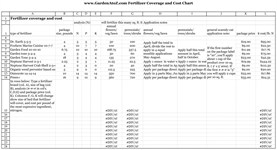Early Summer!
Great gardens come from using a calculator before
spreading fertilizer
Dear Janet,
I have been searching for lawn fertilizer with the
numbers 10-6-4 for spring and 5-10-5 for the fall. I'm having
difficulty locating these two fertilizers. What other numbered
sequence can you recommend to give the same or similar results for
my lawn?
A.R.
Dear A.R.,
Is there a fertilizer collection in your garage -- Tomato Food,
Bulb Booster, etc.? Then you may already have what you need. Give
this column to a number cruncher, with the numbers from labels of
fertilizers you own. Pay that person in fresh cut flowers or fresh
vegetables for doing the math for you!


Or read our Buying fertilizer
recommendations
where you can download a spreadsheet to do
your own calculations.
Numbers on a fertilizer label are a ratio, stating
the percentage of nitrogen, phosphorus and
potassium in that package.
For example, ten pounds of 10-6-4 supplies:
10 percent or 1 pound of nitrogen (10 pounds times 10
percent)
6 percent or 0.6 pounds of phosphorus, and
4 percent or 0.4 pounds of potassium.
Different fertilizer ratios are packaged to address common
problems. High-phosphorus fertilizer is probably stocked at
farmers' supply stores wherever soils are gravelly -- lacking in
phosphorus. A high-nitrogen fertilizer is packaged for plants that
must continually replace leaf, such as mowed lawn, or "heavy
feeders" such as hybrid sweet corn that require more than normal
amounts of nitrogen.
Two fertilizers may be the same ratio but more or less
concentrated. For instance, 5-10-5 is interchangeable with 15-30-15
Miracle Gro. The 15-30-15 is three times as concentrated, so
however many pounds of 5-10-5 your soil test tells you to use,
you'd use one-third as many pounds of the 15-30-15.
For the 10-6-4 your soil test results prescribe, you can apply
any other equivalent fertilizer That might be a 20-12-8 fertilizer,
twice as concentrated, or a 5-3-2 with half the strength.
Instead of one specialty fertilizer you can use a combination.
To replace the ten pounds of 10-6-4 described earlier, you'd weigh
out whatever it takes to yield 1 pound of nitrogen, just over half
a pound of phosphorus and just under half a pound of potassium.
That might be:
8.5 pounds of 12-0-0 blood meal (8.5 pounds times 12
percent nitrogen is 1.02 pounds),
5 pounds of 0-11-0 bone meal (5 pounds times 11 percent
phosphorus is 0.55 pound), plus
three-quarters pound of 0-0-60 muriate of potash (three quarters
of 60 percent potassium is 0.45 pound).
Using a product with a formula that's just right for your soil
and your crop means you can spread fertilizer just once. If you
substitute several fertilizers, spread each ingredient separately
to distribute the nutrients evenly.
Don't be misled by fertilizer packages that claim to be for a
particular plant. Soil is what we're "feeding." If the soil needs a
5-10-5, it doesn't matter if that comes from a 5-10-5 "Tomato Food"
or a 5-10-5 lawn fertilizer.
Gardeners who do not have a soil test to tell them just what
their garden lacks should stick with balanced fertilizers, such as
2-2-2, 13-13-13 or 20-20-20.
Dear Janet,
Is it necessary to cut and remove existing sod before
putting down soil to establish a new bed? To save on time and labor
I was considering cutting the grass very short, then putting down
three to four inches of top soil. Then I would cut through the sod
when I plant and cover the area with 3 to 4 inches of
mulch.
S.
Dear S.,
You can smother sod to make a new bed. Then it's best to wait
for the grass to die, since live grass surfacing through new
plantings can be an obnoxious weed. I don't plant immediately over
smothered sod unless it's under at least four or five inches of
soil and won't be disturbed in planting, since digging into it
inevitably brings it closer to the light. My rule of thumb is
"smother by May to plant in September, smother in September to
plant in May."
Another reason to let a smothered bed wait is that some sod
isn't well mannered lawn but field mowed short. The non-lawn
components in such a mix -- thistle, quack grass, bindweed,
dandelions and others -- can resurface from great depth. While I'm
giving the grass time to die I'm also patrolling for and killing
weedier survivors. If I must plant a suspect bed right away, I
plant annuals rather than perennials so that routine fall
maintenance will give me another chance to remove any persistent
weeds.
Green thumbs up
to water. Turn on the sprinklers! You may remember rain from
weeks ago like it was yesterday but your plants have long since
used up that bounty.
Green thumbs down
to locust trees for deck or patio shade. They host too many
insects that fall off in large numbers, from little green plant
bugs to big (as mites go) red mites.
Originally published 6/28/03